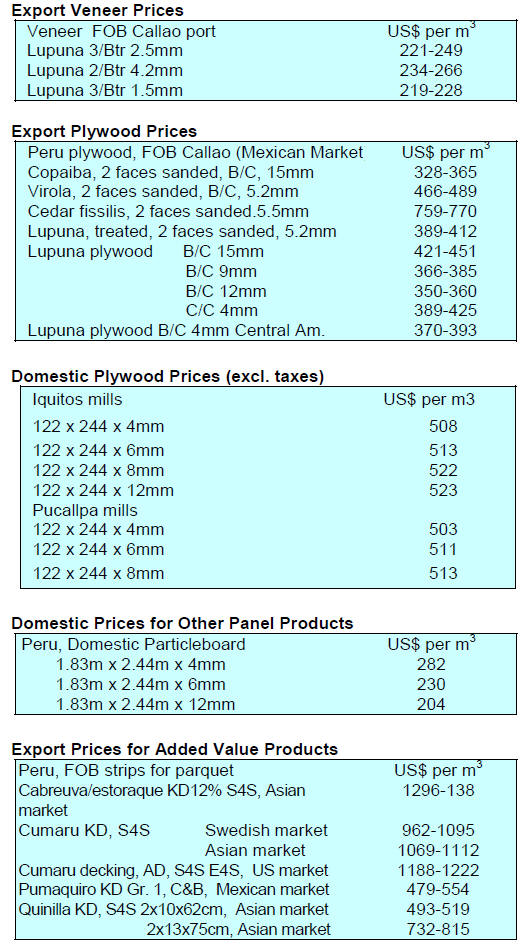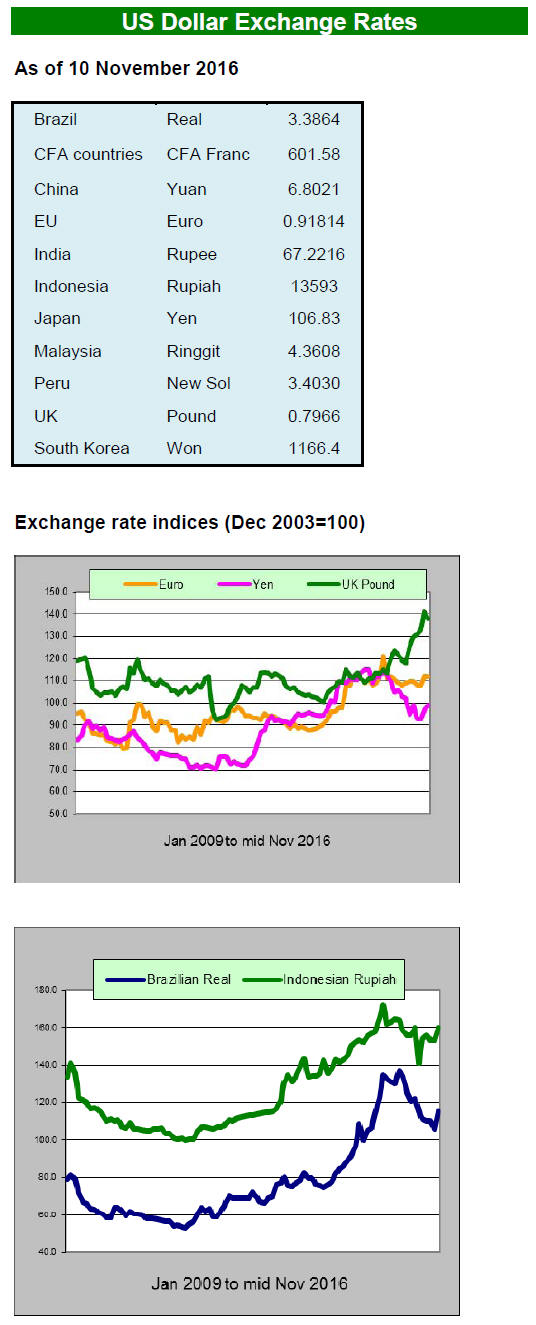2. GHANA
Ports and shipping companies report trade
levels have
fallen
With less than a month until Ghana's presidential elections
business sentiment has become very subdued as the
incumbent and largest opposition parties intensify their
campaigns. This, coupled with various law suits against
and by the Electoral Commission, has distracted
consumers and businesses alike.
In interviews with Citi Business News the Director
of
Hans Shipping Company and the CEO of Koro Shipping
say activity at the ports has slowed noticeably.
They commented that at this time of year both importers
and exporters were usually busy preparing for the festive
season but that the uncertainties surrounding the election
has resulted in traders &playing safe*.
For more see: http://citifmonline.com/2016/11/07/election-feverslows-
business-activities-at-tema-portreport/#
sthash.DX9jsPuL.dpuf
Significant rise in exports in first 8 months of 2016
Ghana recorded a year-on-year rise of almost 12% in the
volume of wood product exports between January and
August this year (2016, 264,889 cu.m; 2015, 237,004
cu.m) and there was a 26% increase in export earnings
over the same period.
There were increases in the export volumes of air-dried
sawnwood, plywood, curl veneers, billets and kindling.
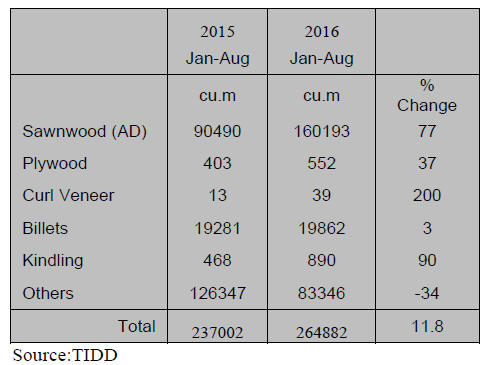
The main species exported were teak (35%), rosewood
(22%), wawa (9%), papao/apa (7%), and ceiba (6%). The
major export markets over the period Jan-Aug 2016 were
Asia (mainly India, China and Vietnam,73%), Africa
(11%), Europe (11%), USA (3%) and the Middle East
(2%).
Contribution of Tropenbos International Ghana lauded
The contribution of Tropenbos International Ghana (TBI),
a forestry-oriented NGO has been recommended for its
contribution to Ghana*s forestry sector.
Dr. Emmanuel Marfo of the Forestry Research Institute of
Ghana (FORIG) said TBI Ghana has played a pivotal role
through building capacity over the years in the
development of the Domestic Timber Policy, the
Procurement Policy on Timber and Timber Products and
the review of the Forest and Wildlife Policy among others.
More at:
http://www.tropenbos.org/country_programmes/ghana
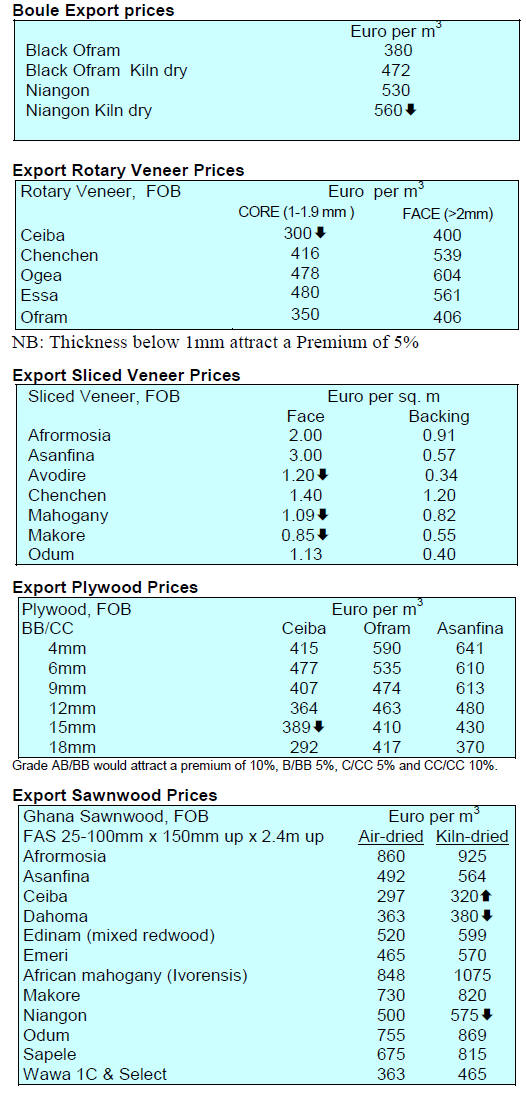
3.
SOUTH AFRICA
Broad based increase in manufacturing
output
Stronger performance in the manufacturing industry
helped keep South Africa*s economy out of a recession
and has led to a slight upward revision in annual growth
forecasts.
The South African statistical office (Statistics South
Africa) has reported that manufacturing output rose almost
5% year-on-year in June, the third consecutive month of
improvement.
For more see:
www.oxfordbusinessgroup.com/news/manufacturing-helpedsouth-
africa%E2%80%99s-economy-avoid-recession
In the past production figures have tended to be
strongly
dependent on mining output but, say the statistical office,
there has been broad based improvement across the
manufacturing sector.
South Africa*s housing market 每 stagnating prices
Housing trend data from South Africa*s First National
Bank (FNB) is pointing to a slowdown in the housing
market and FNB put this down to high house prices which
are out of reach of many potential buyers. Perceptions that
interest rates will rise along with weak consumer
sentiment, especially in terms of job security and the
direction of the economy, has affected sales.
The FNB report says while there has been a year-on-year
improvement in prices especially in the low income areas,
on a quarter-on-quarter basis prices in all four categories
lost ground.
Government and construction firms settle
The South African government and the largest
construction companies have finally settled on the penalty
to be imposed on the main companies which, in 2013,
were accused of bid rigging.
Following an investigation by the Competition Tribunal in
2013, the companies involved were collectively fined R1.4
billion. Under the deal recently announced the companies
investigated will now contribute R1.25 billion over the
next twelve years to be used to fund socio-economic
development in the country. This agreement hopefully
heralds a new era of trust and integrity in the construction
sector.
Online pre-feasibility assessment
The Department of Forest and Wood Science at
Stellenbosch University, the Institute for Commercial
Forestry Research (ICFR) and Forest Economic Service
(FES), all in South Africa, have launched an online tool
the "Forestry Enterprise Simulator" (ForEntSim) which
allows the feasibility of investment by enterprises to be
evaluated.
The Simulator is now available and can be accessed
at: www.forestsim.com
and
http://www.forestsim.com/forentsim-project
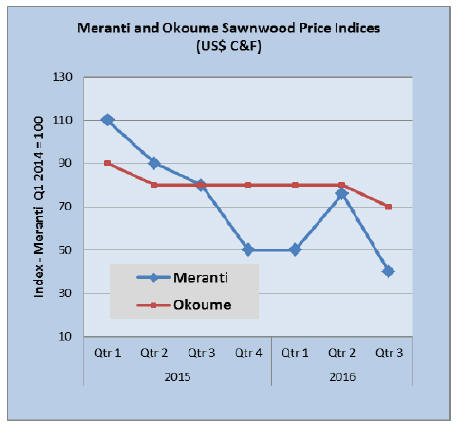
4.
MALAYSIA
East Cost rail link gets underway
Malaysia*s Land and Public Transport Commission
(SPAD) has signed an agreement with China on the
building of East Coast Rail Link (ECRL) as part of its
effort to revitalise the East Coast region of the country, the
so called East Coast Economic Region (ECER). Soft loans
will be provided by China*s Export-Import (Exim) Bank.
The ECER extends over some 66,000 square kilometres or
51% of the total area of Peninsular Malaysia and is home
to over 4 million people in the states of Kelantan,
Terengganu and Pahang, as well as Mersing district ,Johor.
The project is estimated to cost RM55 billion (approx.
US$13 billion) and construction could begin next year.
See: http://www.spad.gov.my/land-publictransport/
rail/east-coast-rail-line-ecrl-project
Boost trade with Africa says minister
Malaysian Minister of International Trade and Industry
(MITI), Datuk Seri Mustapha Mohamed, has said
Malaysia and African countries must work hard to further
develop trade to double this to RM67.2 billion (US$16
billion) by 2021.
The Minister noted that the 2015 trade of just RM33.6
billion (US$8 billion) was far too small in light of the
Africa*s over one billion population and he compared this
to Malaysia's RM420 billion (US$100 billion) annual trade
with China which also had a population of one billion.
MITI recently held a two-day Africa Business promotion
event which featured business seminars, workshops, oneto-
one business meetings and networking sessions
between Malaysian and African businesses.
See:
http://www.miti.gov.my/index.php/pages/view/3758
﹛
Review IUCN Red List says Sarawak Forestry
Corporation CEO
The Chief Executive Officer of the Sarawak Forestry
Corporation (SFC), Wong Ting Chung, has called for a
review of the status of dipterocarps as set out in
International Union for Conservation of Nature (IUCN)
Red List of Threatened Species.
The IUCN lists more than half of the dipterocarp species
in the state as threatened but many species on the list are
commonly found in the forest, they regenerate naturally
and are available in commercial volumes said Wong. The
inclusion of species such as meranti binatoh, meranti
langgai and selangan batu hitam needs to be reviewed.
Wong pointed out that recent research undertaken by the
RIMBA programme (Research for Intensified
Management of Bio-Rich Areas of Sarawak) found that
many species listed as threatened in Sarawak by IUCN
should not be considered as such.
Furniture makers meet sales target in China expo
Malaysian furniture manufacturers are on track to meet
annual sales targets even in the face of the current
weakening of demand in international markets.
The Malaysian Timber Council (MTC) and eighteen
Malaysian furniture manufacturers participated in the
China International Furniture Expo - Furniture China with
an eye on sales of RM40 million. As it turned out the
reported confirmed and potential sales just beat the target
at RM40.03 million. This expo was held at the Shanghai
New International Expo Centre in Pudong, Shanghai.
While it may come as a surprise, China has been in the top
10 main export markets for Malaysian furniture for the
past five years and in 2015 Malaysia*s exports of wood
products, including furniture, to China totalled RM1.9
billion.
See: http://mtc.com.my/wp-content/uploads/2016/10/Furniture-
China-2016-Post-Release.pdf
5. INDONESIA
Congratulations pour in
On 15 November Indonesia became the first country to
issue FLEGT licenses which exempt EU importers from
the due diligence requirements under the EU Timber
Regulation (EUTR).
The first FLEGT licensed shipment arranged by
APKINDO is destined for the UK, Belgium and
Germany.
For more see the FLEGT Newsletter at:
http://www.flegt.org/news/content/viewItem/Indonesia-and-EUlaunch-
FLEGT-licensing-for-legal-timber-to-combat-illegallogging/
15-11-
2016/55?utm_medium=email&utm_source=Apsis%20newsletter
SME support programme
The Ministry of Industry has a scheme to assist SMEs in
the country to secure National Standard (SNI) certification
for their products. This is part of the ministry*s plan for
improving the competitiveness of products manufactured
by SMEs.
Director General (SMEs) in the Ministry of Industry, Gati
Wibawaningsih, said it was important for SMEs to become
more quality conscious for the domestic as well as
international markets.
The ministry is supporting training, mentoring and
technical guidance on attaining local standard certification
as well as on the SVLK.
GDP in-line with forecasts
The Indonesian statistics office has reported that GDP
expanded by 5.02% year-on-year in the third quarter of
2016, down from a revised 5.19% growth in the previous
quarter but in line with forecasts.
Indonesian economic growth was subdued in the third
quarter because of weak economic activity in its main
trading partner countries. This and the budget cuts by
government affected growth.
For more see:
http://www.indonesia-investments.com/news/todaysheadlines/
economy-of-indonesia-gdp-expands-5.02-in-q3-
2016/item7341

Peatland villages to aid restoration
The provincial government of Jambi will establish a
number of village communities in areas where fires have
destroyed the forest and severely affected the underlying
peat. The village community will be advised on peatland
management and supported in the establishment of cash
crops and eventually tree crops.
Nazir Foead of the Peatland Restoration Agency said
it is
vital to speed up the peatland restoration programme to
ensure this unique eco-system survives. It has been
estimated that of the 900,000 ha. of peatland almost
200,000 ha. has been burnt.
6. MYANMAR
Swedish importer fails EUTR 每 fined for
teak imports
A Swedish court has fined a Sedish importer for failing to
satisfy the EU Timber Regulation (EUTR). This court
decision is the first in Sweden to apply the EU Timber
Regulation (EUTR).
The court said the company that imported the teak via a
Singapore trader had violated this regulation as it was
unable to provide sufficient evidence that it had met the
due diligence requirements of the EUTR.
The company in question was fined 17,000 Swedish
kronor (US$1,700). Apparently the company has informed
Sweden*s EUTR regulator that it will no longer source
wood from Myanmar. The court*s verdict follows nearly a
year of injunctions from Swedish authorities and an appeal
by the company.
In its defense the company offered a certificate issued by
MFPMF which the court deemed insufficient evidence of
due diligence. This case is likely to establish a precedent
in other pending cases in the EU.
Barber Cho, who developed the Myanmar Forest Product
Merchant Federation (MFPMF) certification system while
he was Secretary of the Federation, explained that the
system relies on two documents - the Legality of Timber
issued by Forest Department and The Delivery Order
(DO) for teak logs issued by the Myanma Timber
Enterprise (MTE). These documents do not provide full
information on the supply chain or on where and how
harvesting took place. Cho pointed out that if a buyer
wants to check they can obtain the full information from
MTE. He further said it seemed that, in this case, MTE
was unaware of any inquiry from EU.
Local analysts say this decision in Sweden has caused
panic in the timber industry in Myanmar and the
government is being lobbied to act to protect the export
trade. Although Sweden is not the major market for
Myanmar teak exporters fear other countries may also act
to punish importers.
For more see:
C:/Users/Owner/Downloads/Swedish%20Court%20Myanmar%2
0Timber%20PR_FINAL.PDF
Lifting the harvesting suspension 每 plan for the rain
season says industry
The Forestry Department and MTE have officially
announced that about 17,000 hoppus tons of teak and
about 350,000 hoppus tons of hardwood logs would be
harvested after the one-year harvesting suspension is lifted
on 31 April 2017.
In welcoming this news the private sector has alerted the
authorities to the likelihood that there would be a shortage
of logs next year as logging could not be carried out
during the rain season which extends from May to
October. A lifting of the suspension of logging in April
effectively means no new logs will come onto the market
until late in 2017.
Minister calls for review of forest policy
Win Ohn, Minister of Natural Resources and
Environmental Conservation, wants a complete review of
the country*s forest policy. In a recent interview he
condemned the greed of timber traders for the failings of
the forest policy. The minister said a review of Myanmar*s
forest policy was necessary to update the Forest Law of
1992 and the 1992 Forest Policy.
These two pieces of legislation envisaged extensive forest
conservation and the development of downstream wood
industries but this was not achieved as Myanmar has a
high rate of deforestation and the wood processing sector
lags far those of Thailand, Malaysia and Vietnam despite
Myanmar having highly valuable timber resources.
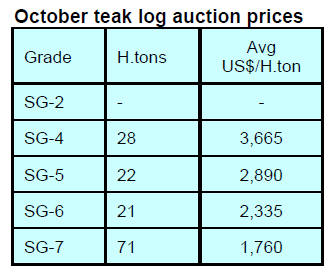
7.
INDIA
Growth in manufacturing hits 22-month high
In a 1 November press release Markiteconomics reports
that Indian manufacturing output hit a 22 month high in
October this year.
The press release says the latest reading was indicative of
a firm improvement in the business climate and that this
spurred growth. Markit says ※Once again, consumer goods
producers outperformed their intermediate and investment
goods counterparts, registering stronger rates of expansion
for both output and new orders.§
Commenting on the latest manufacturing output data,
Pollyanna De Lima, Economist at Markit and author of the
report, said: ※October data provide positive news for
India*s economy as manufacturing output and new orders
expanded at the fastest rates in 46 and 22 months
respectively. The sector looks to be building on the
foundation of the implied pick-up in growth in the
previous quarter.§
For more see:
https://www.markiteconomics.com/Survey/PressRelease.
mvc/1868d49f612441da951f021cbefb7cf3
Home sales rise but prices stagnant
Lower interest rates for home loans and stable house
prices have combined to make new home purchases more
attractive and this has led to a 15% year-on-year rise in
home sales according to Liases Foras Real Estate Rating
and Research.
Data recently released by this research group suggests
2016 home sales were concentrated in the Mumbai
Metropolitan Region and the National Capital Region.
The available data seems to indicate that home buyers
have a preference for homes in development areas that are
nearing completion rather than purchasing well in
advance.
Interest rates on home loans from the State Bank of
India have been cut to 9.1%, the lowest in six years.
For more see
http://economictimes.indiatimes.com/wealth/realestate/
home-sales-rise-on-stagnant-market-cheaperloans/
articleshow/55214071.cms
Funds for state forestry and job creation
In July this year the Indian government passed legislation
which will provide around Rs. 6,000 crores annually to
states authorities to expand efforts on conservation,
protection, improvement and expansion of forest and
wildlife resources of the country.
These funds, says the government press release, ※will not
only help the states and local communities to ensure better
management of their forest resources but will also result in
creation of more than 15 crores man-days of direct
employment.§
The funds for this initiative will be provided from
accumulated fees paid by enterprises which were allowed
to establish businesses on forest land. Since 1980, the
government approved the diversion of 1.29 million
hectares of forestlands for non-forestry purposes,
according to a study by the Centre for Science and
Environment.
For more see: http://cseindia.org/userfiles/campa-factsheet-final-
2015.pdf
Plantation teak prices
Demand for planation teak continues to be good and in
recent shipments some suppliers have been providing
larger diameter log which has lifted prices.

Prices from the three new plantation teak log
suppliers
remain unchanged at:Taiwan P.o.C (US$1036 to 2126 per
cu.m C and F) and Honduras (US$471 to US$539 per
cu.m C and F). Sawn teak from China (US$855 to 1118
per cu.m C and F) and from Myanmar (US$461-2895 per
cu.m Cand F).
Prices for locally sawn imported hardwoods
There have been changes in prices as shown below.
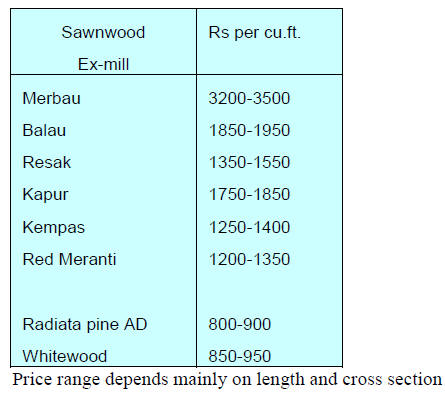
Myanmar teak flitches resawn in India
Demand remains steady. Supplies of sawn teak from
Myanmar and China have kept prices stable.

Prices for imported sawnwood
Demand for imported sawnwood has started to rise and
this has lifted prices for some species.

Prices for WBP Marine grade plywood from domestic
mills
Prices remain unchanged but this is likely to change with
the introduction of the GST (Goods and Services Tax).

8.
BRAZIL
Tax incentives for better forest
management
To encourage forest management units that promote the
efficient and profitable utilisation of forest resources the
Brazilian Government will offer tax incentives in the form
of lower corporate taxes for forestry enterprises.
Acquisitions of buildings will also be exempted
temporarily (until the end of 2019). In addition to
assistance with exemption of taxes on real estate transfers
and all costs associated with land registration procedures
will be lowered by 75%.
The forest management units that attract such relief could
be established by commercial enterprises or cooperatives
comprising rural communities, forest producers, investors
and local authorities. Approved entities will benefit from a
reduction of tax on profits and/or a tax reduction on capital
gains.
The Ministry of Agriculture explained that the aim of this
initiative was to achieve professional forest management
by both private and public entities.
Plan to restore 12 million hectares of forest by
2030
Brazil has the opportunity to build a strong forest-based
economy by meeting the goal of restoring 12 million
hectares of forest areas by 2030 as set out in the
commitments made under the Paris Agreement. However,
there are many challenges and analysts say the process is
behind schedule.
Local analysts point out that to meet the forest restoration
goal it is necessary to have clear strategy, good
governance, transparency and coordination of public
policies. These elements are yet to be implemented fully
and the target requires decisions on the choice of species
(native and exotic) as well as onand how the project will
be funded as it is likely to cost over R$50 billion.
Researchers point out that to be successful sustained
support from government is essential and that rural
communities will need considerable technical guidance
from a multi-disciplinary team.
International funds to support IBAMA
The Brazilian Institute for Environment and Renewable
Natural Resources (IBAMA) had turned to international
donors to finance its routine inspection operations carried
out in the forest as it has insufficient financial resources to
fulfil this basic mission. IBAMA falls under the Ministry
of the Environment (MMA) which successfully negotiated
access to more than R$55 million from the ※Amazon
Fund§.
This fund has already secured contributions of R$2.5
billion from the Norwegian and German governments.
Petrobras, the domestic oil giant, contributed R$13 million
to the fund in 2011. Recently, foreign donors have
signaled their intention to offer addition support which
could add a further R$2.2 billion to the Amazon Fund.
IBAMA plans to use the money to support monitoring and
inspection operations. Behind IBAMA*s decision to resort
to the Amazon Fund are the constant federal budget cuts
which IBAMA said had started to compromise the basic
operations of the Institute.
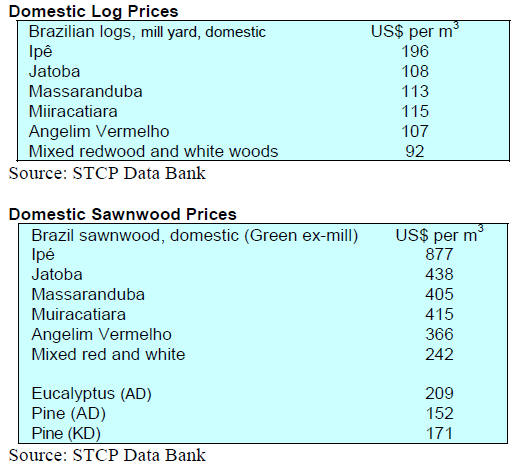
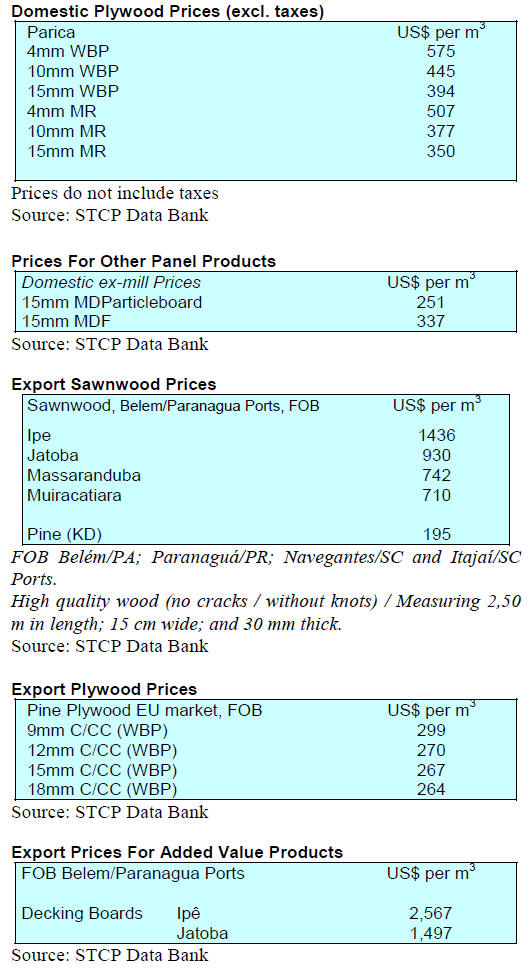
9. PERU
SERFOR meets with National Forest
Confederation
The Executive Director of the National Forest and
Wildlife Service (SERFOR), John Leigh Vetter, recently
met with members of CONAP (Confederacion de
nacionalidades amazonicas del Peru ) which represents the
forest guilds of the Amazonia. His aim was to begin
building a positive attitude to problem solving, to address
the obstacles to forest development and discuss short and
medium term projects.
One of the topics discussed was the establishment of a
Technical Executive, Forest Amazonian Board to deal
with sector issues such more efficient procedures for
deciding on timber concessions allocations.
The meeting concluded with a clear desire on the part of
all participants adopt plans to ensure the good
management of the forest sector and unlock the potential
for development of production.
Extend trade agreements to boost non-traditional
sectors
The President of the Association of Exporters (ADEX),
Juan Varilias, has highlighted the importance of
implementing sectoral development policies to promote
exports of aquaculture, forestry products, non-metallic
mining and biological resources.
Varilias said that to achieve access to international
markets with which Peru has trade agreements it is
necessary to ensure the legal framework in place is
supportive of investment.
He added that the country*s transport infrastructure,
efficiency of public institutions linked to foreign trade and
fiscal incentives for innovation were key.
Competitiveness and sustainability at core of forestry
action plan
The new action plan from the National Forest and Wildlife
Service (SERFOR) will focus on increasing productivity,
competitiveness and sustainability within a framework of
good forest governance and institutional oversight said the
SERFOR Executive Director, Jojn Leigh Vetter.
This was announced at the closing of the XII National
Forest Congress held at the National Agrarian University
La Molina (UNALM), which brought together
professionals, students and entrepreneurs from the sector
from different parts of the country.
Leigh Vetter said he had taken note of the contributions
and recommendations of the Congress in as much as they
were important for the formulation of a new forest
development plan.

